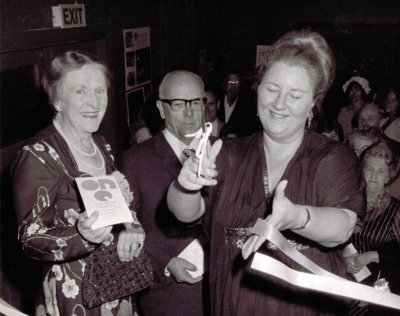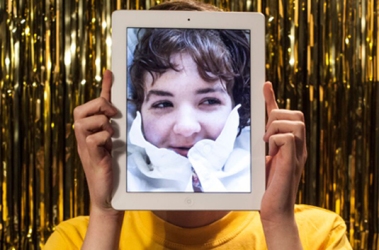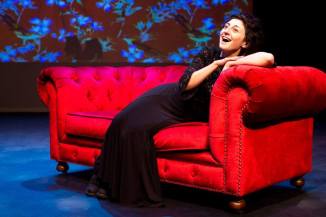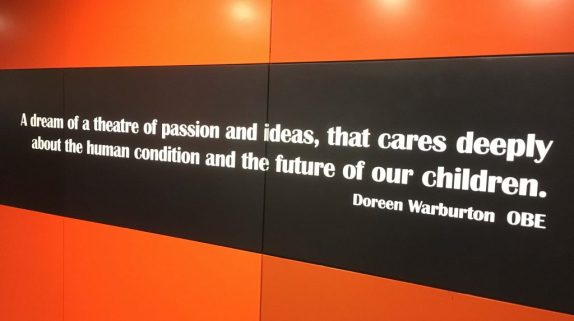A note placed on the seats at the official opening night, July 19, of The Incredible Here and Now, Riverside Theatres, Parramatta gave the news –
Doreen Warburton, 1930 -2017, Founder and Artistic Director Q Theatre
Doreen Warburton and Q Theatre played pioneering roles in the development of professional theatre in Western Sydney
National Theatre of Parramatta dedicates the remaining performances of The Incredible Here and Now in her memory
How often have you attended a funeral where family and friends burst into applause? Tears and laughter, yes, but applause – not just once, but many times? Such was the occasion of Doreen Warburton’s farewell and celebration of her life last week. Doreen died aged 87, July 19, 2017. See the SMH obituary – Evelyn Doreen Warburton OBE, Doreen Gabriel. Actors, family and friends described her as larger than life, charismatic, impassioned, blunt, hugely generous, mother to so many of them, a brilliant artist, administrator and director. She was driven by a fierce sense of social justice and a determination that anyone could be inspired and transformed by their experience of theatre. Doreen grew up in wartime England and trained with the radical Joan Littlewood Theatre. The photo, above, was posted by The Joan Sutherland Performing Arts Centre. – the present day home of the Q. Remembering a life well lived.
 During a period of four years in the mid-1970s, Doreen pioneered a program of bringing theatre workshops and productions by the Sydney based Q Theatre into western Sydney suburbs. Their focus was young people – exposing them to performance opportunities and providing them with theatre skills, while simultaneously building future audiences for the theatre they planned to establish in the region. It was Penrith Council that eventually offered the use of the old Railway Institute and it was there that the Q Theatre made their home. Above, Doreen, right, opens the Q Theatre in Penrith in 1977, accompanied by the Mayor of Penrith, Eileen Cammack.
During a period of four years in the mid-1970s, Doreen pioneered a program of bringing theatre workshops and productions by the Sydney based Q Theatre into western Sydney suburbs. Their focus was young people – exposing them to performance opportunities and providing them with theatre skills, while simultaneously building future audiences for the theatre they planned to establish in the region. It was Penrith Council that eventually offered the use of the old Railway Institute and it was there that the Q Theatre made their home. Above, Doreen, right, opens the Q Theatre in Penrith in 1977, accompanied by the Mayor of Penrith, Eileen Cammack.
 At the funeral, David Hoey described his excitement while a student at Colyton and then Rooty Hill high schools, when he discovered the chance to participate in those first Q Theatre workshops. He participated in some of Q’s subsequent productions and had a “brain explosion” when given the chance to work with the team producing the local rock musical St Marys Kid and another home grown musical story Zilch. Hawkesbury costume designer Leone Sharpe provoked laughter when she described her alarm and apprehension as a 20 year old, when her efforts to restore a hair piece for Doreen went wrong. Right, Doreen as Lady Bracknell in a costume later made by Leone.
At the funeral, David Hoey described his excitement while a student at Colyton and then Rooty Hill high schools, when he discovered the chance to participate in those first Q Theatre workshops. He participated in some of Q’s subsequent productions and had a “brain explosion” when given the chance to work with the team producing the local rock musical St Marys Kid and another home grown musical story Zilch. Hawkesbury costume designer Leone Sharpe provoked laughter when she described her alarm and apprehension as a 20 year old, when her efforts to restore a hair piece for Doreen went wrong. Right, Doreen as Lady Bracknell in a costume later made by Leone.
Hania Radvan is CEO of Penrith Performing and Visual Arts Ltd (PP&VA) which incorporates the Penrith Regional Gallery, Joan Sutherland Performing Arts Centre, Penrith Conservatorium of Music and the Q Theatre. Although she never actually met Doreen, she described her influence as everywhere – in their workshop and performance programs, especially for children and young people.
In an interview earlier this year, producer – Q programs, Nick Atkins said, “The Q is the Joan’s, theatre-making arm. My job, and the role of The Q, which sits inside the building, is to produce and develop professional local theatre. We make theatre for and from the heart of Penrith. We respond to what the local community wants to see, whilst also ensuring the voice of this community is pushed out into the world. We get to export stories as well as import them. Like others, he was a local high school student at Emu Plains, who was inspired by his exposure to Q Theatre, and went on to study a practice based theatre course at University of NSW.
 In March this year he produced Black Birds, a new work by Emele Ugavule and Ayeesha Ash, exploring what it means to be a woman of colour in 2017 in Australia, it’s their personal stories. “The traditional way of theatre is very white, very Western, and very European, which clashes with their experience of the world,” he said.
In March this year he produced Black Birds, a new work by Emele Ugavule and Ayeesha Ash, exploring what it means to be a woman of colour in 2017 in Australia, it’s their personal stories. “The traditional way of theatre is very white, very Western, and very European, which clashes with their experience of the world,” he said.
“We have an artist in residence program. We offer four two-week residencies in our studio. So it’s two weeks space and $2,000 in financial support, and well as drama and technical support from the centre. We also have Propel, which is a play writing program, for 16 to 25-year-old emerging playwrights, in partnership with Australian Theatre for Young People (ATYP) and WestWords. Originate is also for 16’s to 25-year-olds. But it’s more for performance majors and actors. It’s an ensemble project. Eight artists are brought together over three months and create their own work.
 Q’s partnerships and influence are everywhere. From August 10 to 12 The Joan wants you to forget your troubles, come on get happy. How to make a happy meal is a new devised performance created as part of The Q’s Originate project and involving two recent WSU music graduates.
Q’s partnerships and influence are everywhere. From August 10 to 12 The Joan wants you to forget your troubles, come on get happy. How to make a happy meal is a new devised performance created as part of The Q’s Originate project and involving two recent WSU music graduates.
“This year we have a new project called Highway 234, which is another residency program, it’s in collaboration with PYT in Fairfield and PACT in Erskineville. The objective is to see how can we not just empower performers here, but link them in with other centres – because as an artist, it’s great to have your home, but you need to start linking in with other networks.”
Q Programs are a true extension of Doreen’s philosophy, but the more things change, the more they stay the same. Western Sydney still struggles with the same inequitable funding distribution as it did in the 1970s. Nick says, “One per cent of federal funding is being used to try and open up a platform for 10% of Australia’s population to have either some experience in culture, or express their culture. That’s why the programs we run are so vital.”
 Independent actor/director Aanisa Vylet, right, last week completed one of the new Southlands Breakthrough Artist Residencies at the Q by sharing a 15 minute excerpt from her new show The Woman and is deeply grateful for the opportunity. “In commemoration of Doreen Warburton, I will continue to create theatre that ‘…opens doors and windows to people’,” she says.
Independent actor/director Aanisa Vylet, right, last week completed one of the new Southlands Breakthrough Artist Residencies at the Q by sharing a 15 minute excerpt from her new show The Woman and is deeply grateful for the opportunity. “In commemoration of Doreen Warburton, I will continue to create theatre that ‘…opens doors and windows to people’,” she says.
(Photo Credit, the fab Julie Koh)
Roslyn Oades – Abbotsford Convent












































